Abstract
In this study, we construct symmetric explicit symplectic schemes for the non-rotating Konoplya and Zhidenko black hole spacetime that effectively maintain the stability of energy errors and solve the tangent vectors from the equations of motion and the variational equations of the system. The fast Lyapunov indicators and Poincaré section are calculated to verify the effectiveness of the smaller alignment index. Meanwhile, different algorithms are used to separately calculate the equations of motion and variation equations, resulting in correspondingly smaller alignment indexes. The numerical results indicate that the smaller alignment index obtained by using a global symplectic algorithm is the fastest method for distinguishing between regular and chaotic cases. The smaller alignment index is used to study the effects of parameters on the dynamic transition from order to chaos. If initial conditions and other parameters are appropriately chosen, we observe that an increase in energy E or the deformation parameter can easily lead to chaos. Similarly, chaos easily occurs when the angular momentum L is small enough or the magnetic parameter Q stays within a suitable range. By varying the initial conditions of the particles, a distribution plot of the smaller alignment in the X–Z plane of the black hole is obtained. It is found that the particle orbits exhibit a remarkably rich structure. Researching the motion of charged particles around a black hole contributes to our understanding of the mechanisms behind black hole accretion and provides valuable insights into the initial formation process of an accretion disk.
1. Introduction
Symplectic integrators [1,2,3,4,5] are geometric integrators that ensure the long-term stability of energy errors. By constructing a symmetric symplectic algorithm, truncation errors of odd orders can be effectively eliminated. Symplectic algorithms can be categorized into explicit symplectic algorithms and implicit symplectic algorithms. Explicit symplectic integrators have been widely used in black hole spacetime. The constructions of explicit symplectic integrators in Schwarzschild black holes and Reissner–Nordström black holes are very simple because their Hamiltonians can be easily split into four and five independently integrable parts, respectively [6,7]. Then, Wang et al. [8] applied this method to a Hamiltonian for the description of charged particles moving around a Reissner–Nordström–(anti)–de Sitter black hole with an external magnetic field and successfully constructed second- and fourth-order explicit symplectic integrators by splitting that Hamiltonian into six analytically solvable pieces. They discovered that these integrators exhibit exceptional long-term behavior in preserving the boundedness of Hamiltonian errors, irrespective of whether the orbits are ordered or chaotic, as long as appropriate step sizes are employed. For Kerr spacetime, in order to utilize an explicit symplectic integrator, a time transformation function needs to be applied to the Hamiltonian of Kerr geometry [9]. On this basis, Huang et al. [10] successfully constructed time-transformed explicit symplectic schemes in a magnetized deformed Schwarzschild black hole spacetime, and these schemes had good performance in stabilizing energy errors without secular drift. Recently, Zhang et al. [11] successfully constructed a time-transformed explicit symplectic integrator for a Hamiltonian system that describes the movement of charged particles around a non-Schwarzschild black hole that is surrounded by an external magnetic field.
As a subject of continuous exploration [12,13,14], the phenomenon of chaos is gradually becoming known. Until now, although there has been a clear understanding of the chaos characteristics of Newtonian systems, the chaos characteristics of relativistic gravity systems are quite vague. For example, a double fixed-center problem is integrable in Newtonian mechanics, but it has strong chaotic behavior in the relativistic framework [15,16,17,18]. Therefore, the study of chaotic dynamics has been a hot topic in recent years [19,20,21,22,23,24,25,26,27,28]. In the study conducted by Gonçalo A. S. Dias and José P. S. Lemos [29], they successfully constructed thin-shell electrically charged wormholes in d-dimensional general relativity with a cosmological constant. The energy conditions of the static wormhole solutions were analyzed by using the Darmois–Israel formalism, and a linearized stability analysis was carried out. According to the study of A. M. Al Zahrani et al. [30], they discovered that the trajectories of charged particles moving around a weakly magnetized static nonrotating black hole have three different types of asymptotic behavior, and the escape of a particle to infinity exhibits features similar to those of a diffusion process. In the research of Cao et al. [31], it was found that the presence of a fourth constant of motion that is similar to the Carter constant leads to regular behavior of charged particles in moving around a Kerr–Newman black hole that is surrounded by cloud strings, quintessence, and an electromagnetic field. Stuchlík, Z. et al. [32] presented a comprehensive review on the impact of cosmic repulsion and external magnetic fields on the accretion disks surrounding rotating black holes, as well as the jets associated with these rotating configurations. Their study revealed that in ionized Keplerian disks, an external magnetic field combined with the chaotic scattering process crucially influences the fate of the disks, enabling protons and ions with energy reaching eV to exist simultaneously in the vicinity of rotating supermassive black holes with while immersed in a sufficiently strong magnetic field with .
As the study of chaos progresses, numerous methods have been developed to identify chaos. The most typical ways are the Poincaré section method, the Lyapunov index [33], the local Lyapunov index and its spectral distribution [34], the fast Lyapunove index [35,36], the smaller alignment index [37], and the generalized alignment index [38]. Each method has its own unique strengths and weaknesses. For the Poincaré section, its advantage is that it directly reflects the dynamic properties of the system, while its limitation is that it is only suited for studying conservative systems with two degrees of freedom. However, the Lyapunov index measures the intensity of chaos by studying how the orbital deviation vectors change over time, and it can reflect the average separation ratio of two adjacent orbitals over time. This method is applicable to systems of any dimension, but it often requires a long calculation time. On the other hand, the fast Lyapunov index, as the name suggests, can identify chaos faster than the traditional Lyapunov index can. The smaller alignment index, which can accurately identify the possible alignment of two multidimensional vectors, is a fast and effective method for detecting chaos. The generalized alignment index describes the linear independence of deviation vectors, and it is a natural extension of the smaller alignment index for more than two deviation vectors. However, its calculation is considerably complex.
In this study, we construct an efficient explicit symplectic algorithm in a non-rotating Konoplya and Zhidenko black hole and employ it to calculate some chaos indicators. We found the most effective approach and applied it to examine the dynamics of charged particles moving around the black hole. The rest of this study is structured as follows. In Section 2, we construct an explicit symplectic scheme () of the Hamiltonian in the non-rotating Konoplya and Zhidenko black hole spacetime and an explicit scheme of the Hamilton variational equations. In Section 3, the effectiveness of the SALI is verified, and the influences of different algorithms on the effectiveness of the SALI are investigated. In Section 4, we examine the influence of the parameter . Section 5 is devoted to conclusions and discussions.
2. Constructions of Explicit Symplectic Schemes
Due to the highly nonlinear nature of the Hamiltonian function in relativity, it is difficult to directly employ efficient energy-preserving and explicit symplectic algorithms. In this article, the Hamiltonian function is split into multiple sub-Hamiltonians, each of which either has an analytical solution or can be treated with an explicit symplectic algorithm due to the separability of momentum and coordinates. A second-order explicit symplectic algorithm, , is constructed for the total Hamiltonian, which can further lead to a fourth-order explicit symplectic algorithm. This algorithm preserves both energy and the symplectic structure while improving computational efficiency. Although does not preserve energy and the symplectic structure and can accumulate computational errors during its long-term evolution, it offers high precision over short time intervals. Therefore, is commonly used as a universal accuracy benchmark for constructing geometric integration methods within a certain time range. In this article, is also adopted as the standard of accuracy for the algorithm.
2.1. The Konoplya and Zhidenko Black Hole
The metric of the rotating Konoplya and Zhidenko black hole is written as [39]
Note that , . Here, the speed of light c and the constant of gravity G are geometric units: . The parameter is used to measure deviations from the Kerr metric, while a represents the rotation parameter. Additionally, M denotes the mass of the black hole.
Roman Konoplya and Alexander Zhidenko obtained this metric by introducing a static deformation, , into a Kerr spacetime. This deformation modifies the relationship between the black hole’s mass and the position of the event horizon, but preserves the asymptotic properties of the Kerr spacetime. This non-negligible deformation of the Kerr spacetime can result in similar frequencies of black hole ringing in the gravitational-wave signals detected by LIGO and VIRGO [40]. This means that at the existing level of experimental precision, there remains some possibility for alternative theories of gravity.
We let the mass M satisfy ; thus, dimensionless operations of , , and are performed. When , this metric becomes the Kerr metric, and if we set the rotation parameter a to zero, the non-rotating form can be obtained, which gives:
where
Consider the non-rotating form surrounded by an external uniform magnetic field; the dimensionless four-vector potential is [41]
where B is the strength of the magnetic field. A test particle moving around a black hole with charge q is described by the following Hamiltonian:
Here, is the generalized momentum, which is defined as
In this equation, is the four-velocity, and it is the derivative of the coordinate with respect to the proper time . From the Hamiltonian equations , we can deduce that . Consequently, we have two constant momentum components:
In this way, the Hamiltonian can be rewritten as
where , and, due to the resting mass of the charged particle in the time-like spacetime, the Hamiltonian is a conserved quantity, which is often given by
Here, the dimensionless operations for the related qualities are , , , , , , and , where m stands for the mass of the particle.
2.2. Explicit Symplectic Methods for Hamiltonian Equations
Following the methods introduced by Wang et al. [6,7,8], the Hamiltonian (8) can be split into five parts:
where these sub-Hamiltonians are
The equation of motion for the sub-Hamiltonian is , and
Then, we can obtain the time-dependent analytical solutions of :
The other sub-Hamiltonians also have the following equations of motion:
Their analytical solutions are as follows:
All of these solutions are expressed as explicit functions of proper time . Thus, we can construct a second-order explicit symplectic integrator, which is
Then, using the composition scheme of Yoshida (1990) [42], the fourth-order symplectic integrator can be written as
where and .
2.3. Symplectic Schemes of Hamiltonian Variational Equations
By using the method of Huang et al. [10], we can obtain the variational Hamiltonian of Equation (8):
where . The remaining terms are zero, so they do not appear in the equation. This variational Hamiltonian can be split into two parts:
By using the canonical equations and , we can derive the equations of motion for and :
The analytical solutions to the equations of motion (24) are
and the second-order explicit symplectic scheme and a fourth-order explicit symplectic scheme can be written as
2.4. The Carter Constant
For uncharged particles, the Hamiltonian is
By combining this with Equation (9), we obtain the following equation:
where is the Carter constant. The existence of the Carter constant and the conservation of angular momentum and energy imply that the motion of uncharged particles can only follow orderly trajectories.
3. Numerical Evaluations
We consider the parameters , , Q = 8.9 , , and the proper time step . The initial conditions are , , and . The initial value of (positive) is determined by Equation (9). As shown in Figure 1, we obtain the Hamiltonian energy errors of different numerical algorithms. We can see that the Hamiltonian error of is between and , while that of is between and . Furthermore, these errors are bounded and stable. In contrast, the error of increases with the calculation time. This is a natural result because is not a geometric integrator, which means that it does not preserve the symplectic structure of Hamiltonian systems.
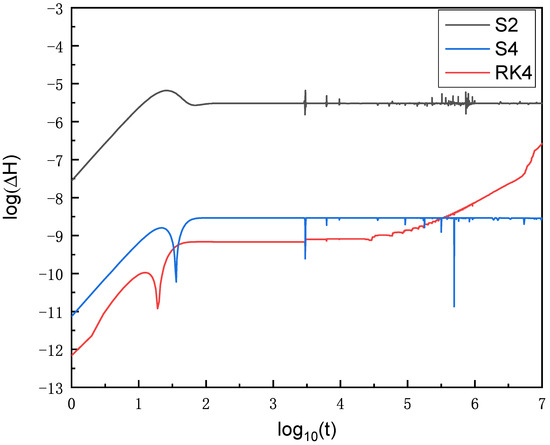
Figure 1.
Hamiltonian energy errors for several algorithms. The adopted algorithms are the second-order explicit symplectic integrator (black line), the fourth-order explicit symplectic integrator (blue line), and the fourth-order Runge–Kutta scheme (red line). The initial conditions and parameters are , , , and .
Then, we utilize some methods to determine the orbital dynamics of the charged test particles moving around the black hole. They are the Poincaré section, FLI, and SALI.
The definition of the FLI is expressed as [43]
where and represent the Euclidean norms of the deviation vector at times and , respectively. If the orbit is chaotic, the FLI will grow exponentially. Conversely, if it is regular, the FLI will exhibit linear growth.
The SALI is given by [37]
where and , are unit vectors. When the orbit is chaotic, the two unit vectors tend to align with each other, leading to SALI . However, for a regular orbit, the values of the SALI will exhibit bounded fluctuations around a positive number.
Figure 2a illustrates the time evolution of the FLIs for four different orbits, while Figure 2b depicts the corresponding Poincaré sections. We can see in Figure 2a that when , the FLI increases exponentially over time, indicating that the corresponding orbit exhibits strong chaos; for the weaker chaotic orbit , the FLI grows more slowly. For ordered orbits and , the FLIs present linear growth. The Poincaré sections, which intuitively indicate whether an orbit is chaotic, are shown in Figure 2b. In the case of chaotic orbits, the points in the Poincaré sections are randomly distributed throughout the plane. In contrast, for ordered orbits, the Poincaré sections display one or more closed curves.
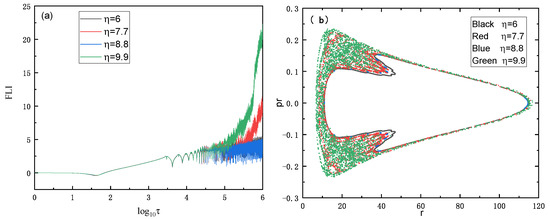
Figure 2.
FLIs for four different orbits and the corresponding Poincaré sections. In (a), we observe that the FLIs increase exponentially over time for chaotic orbits and linearly for ordered orbits. In (b), the Poincaré sections are shown with the same initial conditions as in (a). The initial conditions and parameters are , , Q = 8.9 , , , , and .
In Figure 3, we use different algorithms to obtain the SALIs of the system, whose initial conditions and parameters are the same as those in Figure 2. In Figure 3a, we adopt to calculate the equations of motion and to calculate the variational equations (–). The results indicate that the SALI of the strongly chaotic orbit with approaches zero, while the SALI of the weakly chaotic orbit with appears to be more stable than the former. For ordered orbits with and , the SALIs fluctuate around two constants. A calculation time of is needed here, and this is faster than the FLI method in Figure 2a.
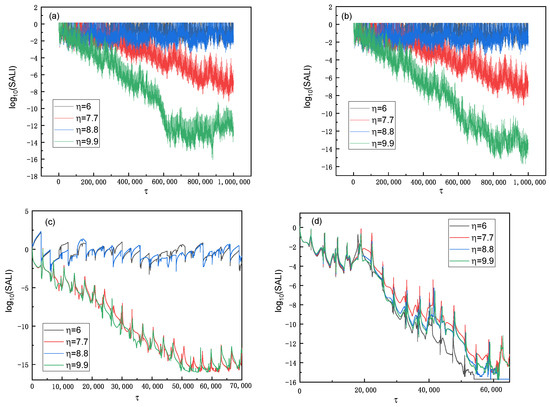
Figure 3.
SALIs computed by using various algorithms. (a) is used to calculate the equations of motion, while is utilized for the variational equations (–); (b) both the equations of motion and the variational equations are calculated by using (–); (c) is used to calculate the equations of motion, while is used to calculate the variational equations (–); (d) RK8 is used to calculate the equations of motion, and the three-particle method is used to calculate the deviation vectors.
In Figure 3b, we utilize the – method to calculate the SALIs, and the results are nearly identical to those in Figure 3a. In Figure 3c,d, the SALIs are obtained by using global symplectic algorithms – and the –three-particle method (due to the SALI requiring the computation of two deviation vectors and both deviation vectors needing triple integration by simultaneously using , this is referred to as the three-particle method), respectively. For the global symplectic method, only a calculation time of is needed to distinguish between chaos and order, making it the fastest approach. However, due to the rapid variation in the deviation vectors resulting from this calculation method, it becomes difficult to differentiate weakly chaotic orbits from strongly chaotic orbits. On the other hand, the SALIs obtained from the –three-particle method lose their effectiveness.
Next, we are interested in examining how the parameters E, Q, L, and influence the orbital dynamics. Due to the computational advantage of SALIs in terms of the required calculation time, we employ the SALI and the Poincaré section to investigate the impacts of the four parameters on the dynamic transition from order to chaos, and the results are shown in Figure 4. In Figure 4(a1), it can be observed that if or , the SALIs are greater than , which is the boundary between chaos and order in [10], indicating that the orbits are ordered. However, for and , the corresponding orbits are chaotic. In Figure 4(a2), when and , the points in the Poincaré sections form two rings, which are known as the Komogorov–Arnold–Moser (KAM) torus. This represents that these two orbits are orderly. When and , the orbits appear to be clearly chaotic.
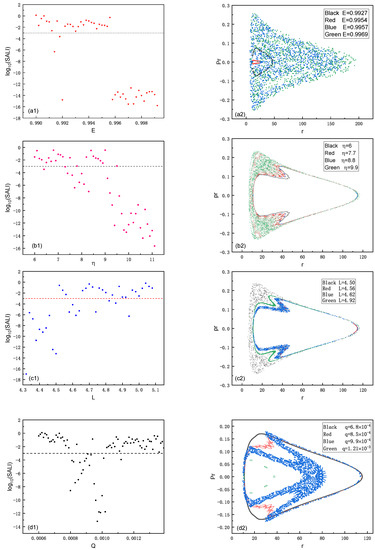
Figure 4.
Panels (a1–d1) reflect the relationship between the SALIs and the four parameters. The initial conditions and parameters are , , , and . (a1) The other parameters are , Q = 8.9 , and ; (b1) the other parameters are , , and Q = 8.9 ; (c1) the other parameters are , Q = 8.9 , and ; (d1) the other parameters are , , and . Panels (a2–d2) reflect the Poincaré sections for the parameters corresponding to those on the left-hand side.
By changing the value of parameter , we find that, in Figure 4(b1), the orbits are regular when and . The orbits transition into chaos when . In addition, if exceeds 9.1, the SALI is smaller than , and as the value of increases, the SALI decreases, and the extent of chaos is strengthened. In Figure 4(b2), the motions of test particles are chaotic in and and regular in and .
We now investigate whether the angular momentum of the test particles influences the dynamic transition from order to chaos. In Figure 4(c1), strong chaos is observed when . When , although there are some weakly chaotic orbits, most of the trajectories exhibit ordered behavior. In Figure 4(c2), the values of angular momentum corresponding to the four orbits are, respectively, , , , and . Notably, the orbit with is a chaotic orbit, while the orbit with is ordered. If we set , the orbit seems to be a typical weak chaotic orbit, and for , the points in the figure form a closed ring, which indicates an ordered orbit.
Finally, we explore the transition of orbits when increasing the value of the magnetic field parameter Q. In Figure 4(d1), it is observed that the orbits transition from ordered to chaotic when and back to ordered when . The Poincaré section corresponding to forms a closed torus, indicating a regular orbit. On the other hand, the Poincaré section of becomes a complicated KAM torus, which is characterized by the presence of six small loops. These small loops belong to the same trajectory and form a chain of islands [13]. Such a torus is considered regular, but it can easily lead to the onset of resonance and chaos. The orbit corresponding to is a weakly chaotic orbit, while the orbit for is strongly chaotic. However, the strength of the chaos in the latter is weaker than that depicted in Figure 4(a2).
In order to conduct a more thorough investigation of the mixing of chaotic and regular motion, we focus on the exploration of chaotic particle dynamics in the X–Z plane. Figure 5 illustrates the chaotic nature of particle trajectories in certain X–Y planes. The step size for r is 0.05, while the step size for is . Deeper shades of red are utilized to illustrate regions in which particles exhibit more prominent chaotic behavior, while lighter shades of blue are employed to indicate areas with less pronounced chaotic behavior. We can clearly observe that when the value of r falls within the range of approximately to , the particles demonstrate a significant manifestation of chaotic behavior. However, when R exceeds , the behavior of the particles becomes orderly and organized. It is noticeable that in certain areas, the chaotic behavior of particles sharing the same value of r changes as varies. The most prominent occurrence of this mixing of the chaotic and regular motion can be observed in the transitional region between chaos and order (roughly, when r falls within the range of 8.7 to 9.8).
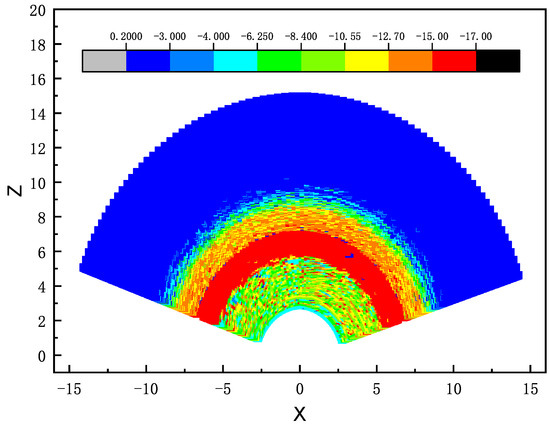
Figure 5.
Chaotic behavior in the X–Z plane. The modified parameters are as follows: The parameter r is varied within the range of and 15, the parameter is adjusted within the range of to , and the parameter is set to a value of . The intensity of color represents the magnitude of the SALI. The more red the color is, the lower the SALI value is, indicating the stronger chaotic behavior of particles. Conversely, the more blue the color is, the weaker the chaotic behavior of the particles is.
4. The Effect of
In this section, we examine the impact of on effective potentials and stable circular orbits and its influence on chaos dynamics through a comparison with the magnetized Schwarzschild black hole.
From Equations (8) and (9), we have
where V represents the effective potential on the equatorial plane , which characterizes the radial movement of a charged particle within an accretion disk encircling the black hole:
The relationship between the effective potential and can be observed in Figure 6, which shows that as increases, the effective potential decreases—see, in particular, the black line with . For the circular motion of the particles, the following conditions must be satisfied:
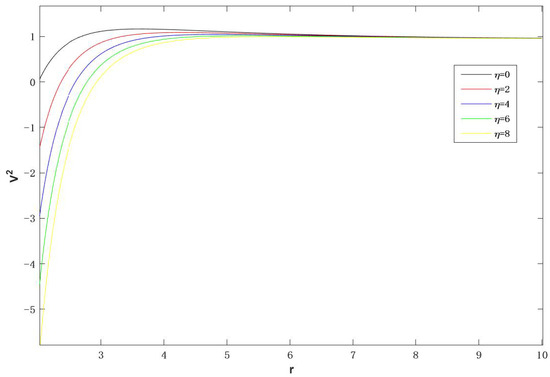
Figure 6.
Radial plot of the effective potentials. The parameters are and . The black line for represents the effective potential of the magnetized Schwarzschild black hole.
The presence of local extrema in the effective potential indicates the existence of circular orbits. If the second derivative of the effective potential is , the potential has local minimal values. These values correspond to the existence of stable circular orbits (SCOs). Specifically, when , such a stable circular orbit is referred to as the innermost stable circular orbit (ISCO). The radii of some SCOs and ISCOs in Figure 6 are listed in Table 1. To enhance the visual representation, we have drawn a rough sketch of the SCOs and ISCOs in Figure 7 for three different values of : 0, 4, and 8. By referring to Table 1 and Figure 7, it is evident that as the parameter increases, the radius of the ISCO increases, while the radius of the SCO decreases.

Table 1.
Radii (r) of the stable circular orbits and innermost stable circular orbits.

Figure 7.
A rough sketch of the SCOs and ISCOs. (a) The parameter is set to 0. The SCO, which is colored black, has a radius of , while the ISCO, which is colored red, has a radius of . (b) The parameter is set to 4. The SCO, which is colored black, has a radius of , while the ISCO, which is colored red, has a radius of . (c) The parameter is set to 8. The black-colored SCO has a radius of , while the red-colored ISCO has a radius of . The upper part of each panel represents the practical trajectories, while the bottom part displays projections of those trajectories.
By setting the value of to zero and maintaining the same initial conditions as those depicted in Figure 4, we obtain the correlations between the SALIs and the energy E, charge Q, and angular momentum L in a magnetized Schwarzschild black hole, and these are displayed in Figure 8. Comparing Figure 8a with Figure 4(a1), we can observe that the relationship between E and the SALI in Figure 8a is generally similar to that in (a1) in Figure 4. By comparing Figure 8b,c with (c1) and (d1) in Figure 4, respectively, we can see that when is set to zero, there is no chaotic behavior observed when the angular momentum L and charge Q are changed.
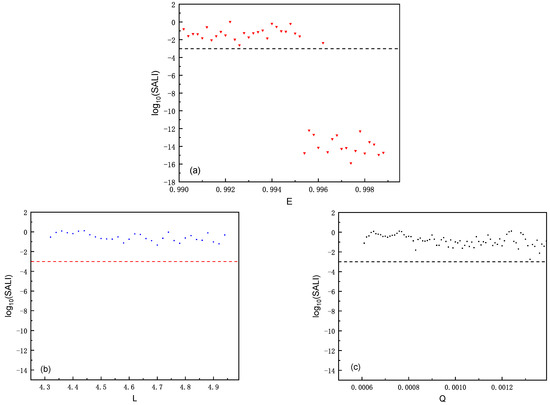
Figure 8.
The relationships between the SALIs and the energy E, charge Q, and angular momentum L in a magnetized Schwarzschild black hole. The relationship between E and the SALI in (a) is generally similar to that in Figure 4(a1). (b,c) indicate that there is no chaotic behavior when the angular momentum L and charge Q are modified in a magnetized Schwarzschild black hole.
5. Conclusions and Discussion
In summary, compared with the traditional method, the fourth-order explicit symplectic scheme is a superior method in non-rotating Konoplya and Zhidenko black hole spacetime. It ensures that the energy errors remain below and do not exhibit growth over time. The numerical results demonstrate that the SALI calculated with the global symplectic algorithm is the fastest method for distinguishing chaotic orbits. However, it is challenging to distinguish weak chaos when using this method. On the other hand, the – and – methods are capable of distinguishing weak chaos, but a longer calculation time is required.
The SALI is employed to study how the parameters affect the dynamic transition from order to chaos. The overall results are dynamic properties of all orbital changes as these parameters change. Specifically, when and the energy E go beyond a certain value, the orbits tend to remain chaotic. Conversely, when the angular momentum L exceeds a certain threshold, while there may still be some chaotic orbits, the majority of the orbits are regular. If we set the magnetic field parameter Q within a suitable range, a chaotic orbit can be easily found. However, if Q is below or exceeds a certain value, the orbits tend to be mainly regular.
By altering the initial conditions of the particles, a distribution plot illustrating the smaller Lyapunov exponent on the X–Z plane of the black hole was generated. It was observed that the particle orbits manifest an exceptionally diverse and intricate structure, and when the orbital radius of the particles r falls within the range of to , we can easily find the mixing of chaotic and regular motion.
The influence of the newly introduced parameter can cause a contraction in the SCO and an expansion in the ISCO. Furthermore, it can lead to chaotic behavior of the particles, which is not present in Schwarzschild black holes.
Researching the motion of charged particles around a black hole contributes to understanding the mechanisms of black hole accretion and provides insights into the initial formation process of accretion disks. Building upon this foundation, future considerations may involve studying the dynamic behavior of photons around a black hole, which can offer perspectives for investigating black hole shadows.
Author Contributions
Conceptualization, methodology, and supervision, G.H. (Guoqing Huang); calculation, software, and writing—original draft, G.H. (Guangdong He); examination, A.H. All authors have read and agreed to the published version of the manuscript.
Funding
This research was funded by the National Natural Science Foundation of China (grant nos. 11533004 and 11663005).
Data Availability Statement
Not applicable.
Acknowledgments
The authors are very grateful to Huang Zhongqiang and Li Yaling for their technical support for the software and numerical calculations.
Conflicts of Interest
The authors declare no conflict of interest.
References
- Swope, W.C.; Andersen, H.C.; Berens, P.H.; Wilson, K.R. A computer simulation method for the calculation of equilibrium constants for the formation of physical clusters of molecules: Application to small water clusters. J. Chem. Phys. 1982, 76, 637–649. [Google Scholar] [CrossRef]
- Ruth, R.D. The title of the cited article. Canonical Integr. Tech. 1983, 30, 2669–2671. [Google Scholar]
- Wisdom, J.; Holman, M. Symplectic maps for the N-body problem. Astron. J. 1991, 102, 1528–1538. [Google Scholar] [CrossRef]
- Chambers, J.E.; Murison, M.A. Pseudo-high-order symplectic integrators. Astron. J. 2000, 119, 425. [Google Scholar] [CrossRef]
- Ni, X.T.; Wu, X. New adaptive time step symplectic integrator: An application to the elliptic restricted three-body problem. Res. Astron. Astrophys. 2014, 14, 1329–1342. [Google Scholar] [CrossRef]
- Wang, Y.; Sun, W.; Liu, F.; Wu, X. Construction of Explicit Symplectic Integrators in General Relativity. I. Schwarzschild Black Holes. Astrophys. J. 2021, 907, 66. [Google Scholar] [CrossRef]
- Wang, Y.; Sun, W.; Liu, F.; Wu, X. Construction of Explicit Symplectic Integrators in General Relativity. II. Reissner-Nordström Black Holes. Astrophys. J. 2021, 909, 22. [Google Scholar] [CrossRef]
- Wang, Y.; Sun, W.; Liu, F.; Wu, X. Construction of Explicit Symplectic Integrators in General Relativity. III. Reissner-Nordstro¨m-(anti)-de sitter Black Holes. Astrophys. J. Suppl. Ser. 2021, 254, 8. [Google Scholar] [CrossRef]
- Wu, X.; Wang, Y.; Sun, W.; Liu, F. Construction of Explicit Symplectic Integrators in General Relativity. IV. Kerr Black holes. Astrophys. J. 2021, 914, 63. [Google Scholar] [CrossRef]
- Huang, Z.; Huang, G.; Hu, A. Application of explicit symplectic integrators in a magnetized deformed schwarzschild black spacetime. Astrophys. J. 2022, 925, 158. [Google Scholar] [CrossRef]
- Zhang, H.; Zhou, N.; Liu, W.; Wu, X. Charged particle motions near non-schwarzschild black holes with external magnetic fields in modified theories of gravity. Universe 2021, 7, 488. [Google Scholar] [CrossRef]
- Lorenz, E.N. Deterministic nonperiodic flow. J. Atmos. Sci. 1963, 20, 130–141. [Google Scholar] [CrossRef]
- Henon, M.; Heiles, C. The applicability of the third integral of motion: Some numerical experiments. Astron. J. 1964, 69, 73. [Google Scholar] [CrossRef]
- Sussman, G.J.; Wisdom, J. Numerical evidence that the motion of pluto is chaotic. Science 1988, 241, 433–437. [Google Scholar] [CrossRef] [PubMed]
- Vieira, W.M.; Letelier, P.S. On the integrability of halo dipoles in gravity. Phys. Lett. A 1997, 228, 22–24. [Google Scholar] [CrossRef]
- Contopoulos, G. Periodic orbits and chaos around two black holes. Proc. R. Soc. London. Ser. A Math. Phys. Sci. 1990, 431, 183–202. [Google Scholar]
- Contopoulos, G.; Papadaki, H. Newtonian and relativistic periodic orbits around two fixed black holes. Celest. Mech. Dyn. Astron. 1993, 55, 47–85. [Google Scholar] [CrossRef]
- Contopoulos, G.; Voglis, N.; Efthymiopoulos, C. Chaos in Relativity and Cosmology. Int. Astron. Union Colloq. 1999, 172, 1–16. [Google Scholar] [CrossRef]
- Guéron, E.; Letelier, P.S. Geodesic chaos around quadrupolar deformed centers of attraction. Phys. Rev. E 2002, 66, 046611. [Google Scholar] [CrossRef]
- Dubeibe, F.L.; Pachón, L.A.; Sanabria-Gómez, J.D. Chaotic dynamics around astrophysical objects with nonisotropic stresses. Phys. Rev. D 2007, 75, 023008. [Google Scholar] [CrossRef]
- Hu, A.R.; Huang, G.Q. Dynamics of charged particles in the magnetized γ spacetime. Eur. Phys. J. Plus 2021, 136, 1210. [Google Scholar] [CrossRef]
- Li, D.; Wu, X. Chaotic motion of neutral and charged particles in a magnetized ernst-schwarzschild spacetime. Eur. Phys. J. Plus 2018, 134, 1–12. [Google Scholar] [CrossRef]
- Li, D.; Wang, Y.; Deng, C.; Wu, X. Coherent post-newtonian lagrangian equations of motion. Eur. Phys. J. Plus 2020, 135, 390. [Google Scholar] [CrossRef]
- Wang, Y.; Wu, X. Next-order spin–orbit contributions to chaos in compact binaries. Class. Quantum Gravity 2011, 28, 025010. [Google Scholar]
- Huang, G.Q.; Wu, X. Dynamics of the post-newtonian circular restricted three-body problem with compact objects. Phys. Rev. D 2014, 89, 124034. [Google Scholar] [CrossRef]
- Huang, G.; Ni, X.; Wu, X. Chaos in two black holes with next-to-leading order spin–spin interactions. Eur. Phys. J. C 2014, 74, 3012. [Google Scholar] [CrossRef][Green Version]
- Wu, X.; Huang, G.Q. Ruling out chaos in comparable mass compact binary systems with one body spinning. Mon. Not. R. Astron. Soc. 2015, 452, 3167–3178. [Google Scholar] [CrossRef][Green Version]
- Huang, L.; Wu, X.; Ma, D. Second post-Newtonian Lagrangian dynamics of spinning compact binaries. Eur. Phys. J. C 2016, 76, 488. [Google Scholar]
- Dias, G.A.S.; Lemos, J.P.S.; Shoom, A.A. Thin-shell wormholes in d-dimensional general relativity: Solutions, properties, and stability. Phys. Rev. D 2010, 82, 084023. [Google Scholar] [CrossRef]
- Al Zahrani, A.M.; Frolov, V.P.; Shoom, A.A. Critical escape velocity for a charged particle moving around a weakly magnetized Schwarzschild black hole. Phys. Rev. D 2013, 87, 084043. [Google Scholar] [CrossRef]
- Cao, W.; Liu, W.; Wu, X. Integrability of Kerr–Newman spacetime with cloud strings, quintessence and electromagnetic field. Phys. Rev. D 2022, 105, 124039. [Google Scholar] [CrossRef]
- Stuchlík, Z.; Kološ, M.; Kovář, J.; Slaný, P.; Tursunov, A. Influence of Cosmic Repulsion and Magnetic Fields on Accretion Disks Rotating around Kerr Black Holes. Universe 2020, 6, 26. [Google Scholar] [CrossRef]
- Lyapunov, A.M. The general problem of the stability of motion. Int. J. Control 1992, 55, 531–534. [Google Scholar] [CrossRef]
- Szezech, J.; Lopes, S.; Viana, R. Finite-time lyapunov spectrum for chaotic orbits of non-integrable hamiltonian systems. Phys. Lett. A 2005, 335, 394–401. [Google Scholar] [CrossRef]
- Froeschlé, C.; Lega, E.; Gonczi, R. Fast Lyapunov Indicators. Application to Asteroidal Motion. Celest. Mech. Dyn. Astron. 1997, 67, 41–62. [Google Scholar] [CrossRef]
- Froeschlé, C.; Lega, E. On the structure of symplectic mappings. The fast lyapunov indicator: A very sensitive tool. Celest. Mech. Dyn. Astron. 2000, 78, 167–195. [Google Scholar]
- Skokos, C. Alignment indices: A new, simple method for determining the ordered or chaotic nature of orbits. J. Phys. A 2001, 34, 10029–10043. [Google Scholar] [CrossRef]
- Skokos, C.; Antonopoulos, T.C.B. Geometrical properties of local dynamics in hamiltonian systems: The generalized alignment index (GALI) method. Phys. D Nonlinear Phenom. 2007, 231, 30–54. [Google Scholar] [CrossRef]
- Konoplya, R.A.; Zhidenko, A. Detection of gravitational waves from black holes: Is there a window for alternative theories? Phys. Lett. B 2016, 756, 350–353. [Google Scholar] [CrossRef]
- Abbott, B.P.; Abbott, R.; Abbott, T.D.; Abernathy, M.R.; Acernese, F.; Ackley, K.; Adams, C.; Adams, T.; Addesso, P.; Adhikari, R.X.; et al. Observation of Gravitational Waves from a Binary Black Hole Merger. Phys. Rev. Lett. 2016, 116, 061102. [Google Scholar] [CrossRef]
- Razzaq, A.; Rahim, R. Particle dynamics in non-rotating konoplya and zhidenko black hole immersed in an external uniform magnetic field. Eur. Phys. J. Plus 2023, 138, 208. [Google Scholar] [CrossRef]
- Yoshida, H. Construction of higher order symplectic integrators. Phys. Lett. A 1990, 150, 262–268. [Google Scholar] [CrossRef]
- Wu, X.; Zhang, H. Chaotic dynamics in a superposed weyl spacetime. Astrophys. J. 2006, 652, 1466. [Google Scholar] [CrossRef]
Disclaimer/Publisher’s Note: The statements, opinions and data contained in all publications are solely those of the individual author(s) and contributor(s) and not of MDPI and/or the editor(s). MDPI and/or the editor(s) disclaim responsibility for any injury to people or property resulting from any ideas, methods, instructions or products referred to in the content. |
© 2023 by the authors. Licensee MDPI, Basel, Switzerland. This article is an open access article distributed under the terms and conditions of the Creative Commons Attribution (CC BY) license (https://creativecommons.org/licenses/by/4.0/).